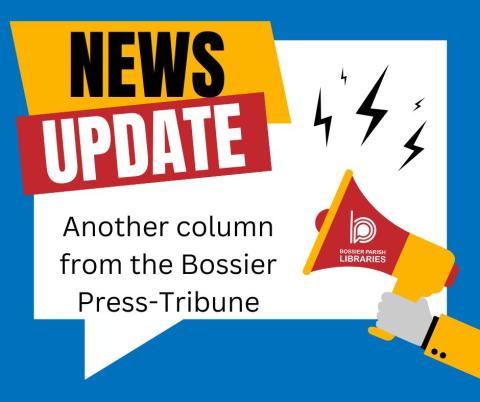
Winning World War II from the Kitchen
In the archives of the Bossier Parish Libraries History Center is a 1944 photograph of Mrs. Bonvillion’s fifth grade class at Bossier Grammar School (now Bossier Elementary School). The students proudly hold a banner that proclaims, “We brought the GREASE to write the PEACE.” They brought waste fats and tin cans that were needed to make munitions for the armed services during World War II.
Schools were not the only places in which kitchen fats were collected. Lettie VanLandingham was Bossier Parish’s Home Demonstration Agent through the Depression, WWII and into the 1950’s. Home Demonstration agents were provided by Louisiana State University’s Cooperative Extension Service. They taught women homemaking techniques, particularly related to food production and preparation, through organized clubs and general outreach in even the smallest of their parish’s communities.
In “The Bossier Banner” throughout WWII, Ms. VanLandingham advised homemakers on how to contribute to the war effort in their kitchens by saving cooking fats, which she referred to as a “miracle material”
“If the necessary supply of fats and oils is to be maintained, Louisiana housewives will have to save more frying-pan drippings that are unfit for further use.”
“By salvaging grease otherwise ready for the garbage, home-makers can assure themselves of more fats and oils, and at the same time supply the armed forces with the raw materials to make TNT, incendiaries, vaccines and thousands of battle-field necessities.”
“To make a hundred essentials for the battlefield, as well as the home front, they are vitally needed. One pound of fat saved in a kitchen will help supply the medicines to maintain a hospital bed for 12 days. One pound of fat will also help to make 19 pounds of synthetic rubber for ambulance tires. Save all fats. They are vital to help make these and other essentials like parachutes, bullets and soaps for the battlefield and home front. By saving one teaspoonful of fat each day for a month, the housewife will find that she has salvaged one pound of fat.”
Ms. Van Landingham’s dispatches on saving fats made it clear that recycling during WWII was not only good for the life of the planet, it helped to save lives of soldiers. Another important reason for saving fats, though perhaps not as noble, was that it was good for the wartime homemaker’s wallet, which would have included ration stamps or coupons in addition to money. Food was rationed during World War II for a variety of reasons, including supply and demand issues, military needs, and the economy, including keeping inflation in check. Food was mostly rationed using a point system that adjusted frequently for shifts in supply and demand. Products with high demand and low availability needed more points than items that were easier to obtain. Point value on a blue ration stamp were for foods that were processed and canned, frozen, dried or otherwise pre-packaged. Red stamps were for meat, cheese and fats. Therefore, Ms. Landingham pointed out,
“The more used kitchen fats home-makers turn in, the less likely are point values to rise on such items as shortening, lard and cooking oils,” she said. “Each pound of used kitchen fats means two extra red ration points and 4 cents to the home-maker. In other words, the home-maker who saves kitchen fats and sells them, trades a commodity she can’t use for one she can. In return for her salvaging job, she finds more fats and oils on open shelves, and she has more red points with which to buy them.
Bring or send any kitchen fats you have to the home demonstration club meetings and it will be delivered to some of the dealers who are taking care of it,” concludes the agent.
To learn more about life during World War II, join us for World War Tuesdays on the second Tuesday of the month from 10:30 – noon. The next meeting is July 9th and will feature food issues on the home front with the development of Victory Gardens and home food preservation. This meeting will be in the new Central Library building 850 City Hall Drive, Bossier City, LA (across Beckett Street from the original History Center and the “old” Central Library). We are open M-Th 9-8, Fri 9-6, and Sat 9-5. Our phone number is (318) 746-7717 and our email is history-center@bossierlibrary.org
For other fun facts, photos, and videos, be sure to follow us @BPLHistoryCenter on FB, @bplhistorycenter on TikTok, and check out our blog http://bpl-hc.blogspot.com/.